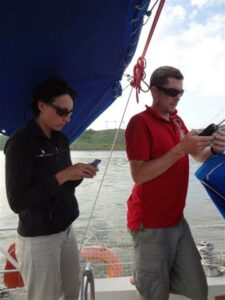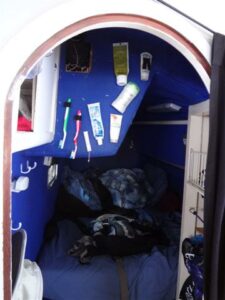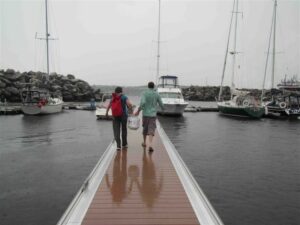
Crew members Grant and Pascale make final preparations.
Finally leaving Gananoque on June 17 after several weeks of preparation: is a boat ever really ready? There is always something to finalize, improve or perfect … But everything is in order now and we can cast off! The journey from Gananoque to Montreal takes three days, navigating by day. Our days (filled by all the organizing to do on board) are punctuated by the passage of several locks: we get close, we look for the waiting dock, Grant disembarks and uses the dock phone to find that the wait will be about 30 or 45 minutes, maybe more. A gigantic container ship leaves the lock, then it’s our turn,dropping nearly 40 feet and exiting on the other side. We feel very humbled by all those monsters … In all, we drop about 160 feet! The first lock is new for all on board, but we quickly become experts, look how many there are!
On to Montreal for a meeting with the media, and the WWF and Students on Ice teams: We get some last-minute advice and a lot of “to the north!” and “bon voyage!”. It’s hot – around 35 C, the inside of the boat is an oven. We look forward to the northern countries! A red buoy and then a green buoy, and we finally arrive in Quebec City, where we decide to stop two days to enjoy the stores one last time (not for shopping but to refuel) with the help of Pascale’s parents. And finally a little necessary work: raising the mast for Grant, last minute shopping for Pascale, work on deck for Valentine – the crew kept busy!

The secret to maximizing space on a small ship - Velcro!
About the crew… Grant is the captain, Pascale is “Madame Velcro” and I am “Mrs. Ty-rap” this week. The three of us leave nothing to chance. Grant tests and checks everything, pampers the engine and listens to it closely, while Pascale and I arrange, repair and re-arrange and re-repair…! Pascale hangs anything that can be hung with Velcro (even her toothbrush) and if that doesn’t work, I’m never far away with Ty-rap (cable ties). We are worried about this Velcro addiction… We even hang our cups 90 degrees from normal! We’ll let you know how it works out.
We’re stocked with water and gasoline, and the boat and crew are ready. Leaving Quebec on Sunday morning (June 24, St. Jean Baptiste Day), and heading towards Greenland after a few stops along the St. Lawrence!
Follow the voyage here.




